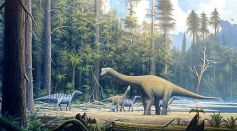Tags: Exoplanet

Young, Close Earth-Sized Hot Exoplanet Offers Unique Insights into Planetary Evolution
Atmospheric Haze Replicated in Laboratory To Help Detect Exoplanet With Earth-Like Conditions
Some Sub-Neptune Planets Shrink Down to Super-Earth [Study]
Astronomers Discover Exoplanet Hosting Sandy Clouds in Its Atmosphere Using JWST Data [Study]

Jurassic Exoplanets Might Be Easier To Spot Than Modern Earth, Mesozoic Era Provides Key in Finding Extraterrestrial Life
James Webb Space Telescope Could Help Explain Hellish Super-Earth’s Strange Signals That Keep Bizarre Exoplanet From Losing, Re-Growing Atmosphere
Planetary Collision: 2 Icy Exoplanets Crash in Space Produce Blaze of Light, Enormous Plumes of Dust

Exoplanet K2-18b Could Be a Hycean Water World That Supports Life, JWST Observations Reveal
James Webb Space Telescope Discovers Methane and Carbon Dioxide in K2-18 b; Can It Be a Habitable Planet That Support Life?

Neptune-Sized Exoplanet Blimps in and Out of Sight in a Single Orbit; Bizarre Atmosphere Leakage Found in Front and Not Behind
What Are Signs of Extraterrestrial Life in Space? Expert Claims NASA’s Webb Could Detect Biological Activity in Exoplanets

Unlikely Exoplanet With Clouds Made of Glass and Titanium Over 250 Light Years Away 'Shouldn't Exist'
Exoplanet That Shouldn’t Exist Named the Most Reflective Planet Due to Its Metallic Clouds

Jupiter-Like Exoplanet Defies Doom Even After a Cosmic Cataclysm at the Hands of Its Own Sun

No, It's Not Planet X: Rogue Exoplanet Could Be Hiding in Oort Cloud at Solar System's Edge, Study Suggests
Scorching Hot Exoplanet Contains Unusual Amount of Nickel, Could Have Swallowed a Smaller Neighboring Planet
Giant Magellan Telescope Will Be Equipped With Large Earth Finder To Search for Biosignatures in Exoplanets
Exoplanet Wasp-18 B Has Strong Magnetic Field, Shows Signs of Water Vapor [Study]
Volcanic Activity in an Exoplanet 90 Light-Years Away From Earth May Generate an Atmosphere

James Webb Space Telescope Takes Its First Up-Close Look at the Mysterious Atmosphere of a Mini-Neptune Exoplanet
Most Popular

Starlink Satellite Explodes in Orbit; SpaceX Confirms It'll Re-Enter Earth

Aurora Phenomenon: How Geomagnetic Storms and Space Weather Are Lighting Up the World

What Causes Monsoons? How Seasonal Winds Shifts and Climate Patterns Drive Rainfall

Ocean Warming Explained: Why Climate Science Shows Sea Temperature Rise Is Speeding Up




